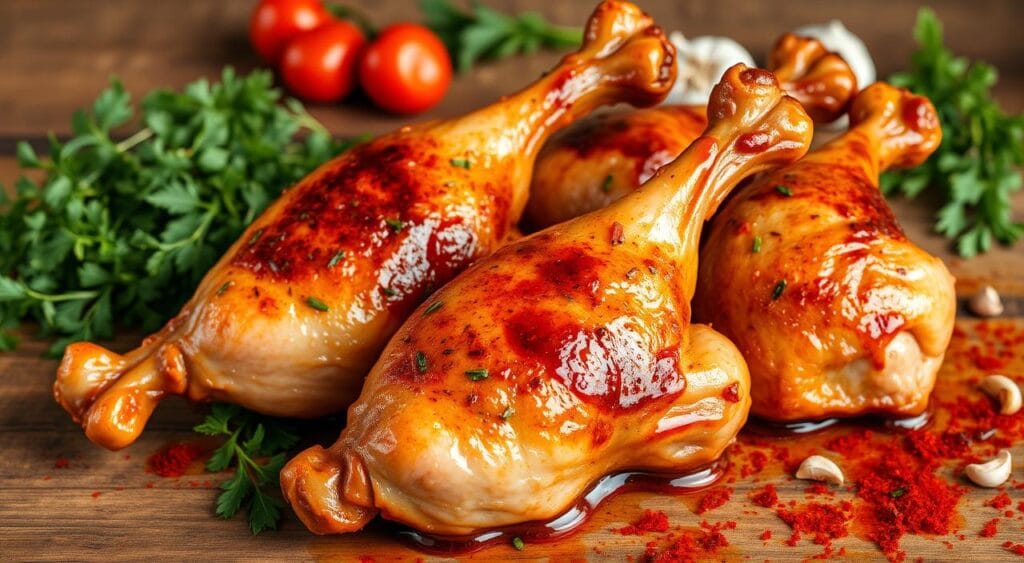Table of Contents
As the crisp autumn breeze whispers outside, the scent of slow-roasted Turkey Legs Recipe fills the kitchen. It invites you to enjoy a delicious and comforting meal. The thought of biting into perfectly cooked turkey legs is exciting. They have golden-brown skin and a juicy, tender interior.
Whether you’re hosting a family gathering or just want a tasty dish, this turkey legs recipe is perfect. It’s sure to become a favorite.
In this guide, we’ll share key tips for choosing and preparing the best turkey legs. You’ll learn the secret to crispy, tender, and flavorful results every time. We’ll cover seasoning, troubleshooting common issues, and more. You’ll become a turkey leg expert in your kitchen.
Key Takeaways
- Discover the secrets to selecting the perfect turkey legs for juicy, tender results
- Learn the essential steps for proper thawing and preparation to ensure a flawless outcome
- Explore a variety of delectable seasoning and marinade options to elevate the flavor of your turkey legs
- Uncover troubleshooting tips to address common issues like tough meat or dry texture
- Gain the confidence to create restaurant-quality turkey legs in the comfort of your own home
Essential Tips for Selecting and Preparing Turkey Legs
Creating the perfect turkey drumsticks recipe starts with picking the right turkey legs. You can choose fresh or frozen. Knowing how to thaw and prepare them is key for juicy, tender results.
Choosing Fresh vs. Frozen Turkey Legs
For smoked turkey legs or baked turkey legs, fresh or frozen makes a big difference. Fresh legs have a stronger flavor and firmer texture. But, they might be harder to find.
Frozen legs are more convenient and available all year. They need careful thawing, though.
Proper Thawing Methods
If you picked frozen turkey drumsticks, thawing them right is crucial. The best way is to thaw them in the fridge slowly. This keeps them safe and even.
Don’t thaw them at room temperature. It’s not safe and can lead to bacteria growth.
Basic Preparation Steps
- Rinse the turkey legs under cool running water to remove any excess ice or debris.
- Pat the legs dry with paper towels, ensuring they are completely moisture-free.
- Trim any excess skin or fat, leaving just enough to provide a crispy, golden-brown finish.
- Season the legs generously with your desired spices, herbs, or marinades to infuse them with flavor.
By following these tips, you’ll make smoked turkey legs or baked turkey legs that are juicy, tender, and full of flavor.
The Ultimate Turkey Legs Recipe
Find a versatile turkey legs recipe for oven-roasting, BBQ, or air frying. You can choose from oven-roasted, BBQ, or air-fried turkey legs. This guide offers step-by-step cooking methods for perfect results every time.
Oven-Roasted Turkey Legs
Preheat your oven to 375°F (190°C) for oven-roasted turkey legs. Dry the turkey legs with paper towels and season with herbs, spices, or salt and pepper. Place them on a baking sheet or roasting pan, leaving space between them.
Roast for 45-60 minutes, or until the internal temperature hits 165°F (74°C). Baste the turkey legs with juices for a crispy, golden skin.
BBQ-Grilled Turkey Legs
For a smoky twist, grill the turkey legs indirectly. Brush them with BBQ sauce or rub. Place them on the grill, away from direct heat, and cook for 45-60 minutes, turning occasionally.
Until the internal temperature reaches 165°F (74°C). Baste with more BBQ sauce for the last 15 minutes for a caramelized finish.
Air Fryer Turkey Legs
Preheat your air fryer to 400°F (200°C) for air-fried turkey legs. Dry and season the turkey legs with your favorite spices. Place them in the air fryer basket, leaving space.
Air fry for 25-30 minutes, flipping halfway. Cook until the internal temperature is 165°F (74°C) and the skin is crispy.
These turkey legs are juicy, tender, and full of flavor. Try different seasonings and techniques to find your favorite recipe.

Marinades and Seasonings for Flavorful Results
Make your turkey legs recipe taste amazing with the right marinade and seasoning. You can use classic herb and butter mixes or spicy BBQ rubs. These methods can add delicious flavors to your turkey legs.
Herb and Butter Marinade
For a tasty flavor, try a herb and butter marinade. Mix fresh herbs like rosemary, thyme, and parsley with melted butter, garlic, and lemon juice. Coat the turkey legs well and marinate for at least 30 minutes before cooking.
Spicy BBQ Rub
Want crispy turkey legs with a bold taste? Create a BBQ spice blend with paprika, chili powder, brown sugar, and dried herbs. Rub it all over the turkey legs and let it sit for 15-20 minutes before cooking.
Brining for Juiciness
To keep your bbq turkey legs juicy, try brining them. Mix 1/4 cup of salt in 4 cups of water. Soak the turkey legs in it and refrigerate for at least 2 hours before cooking. This keeps the meat moist and tender.

“Marinades and seasonings are the secret to taking your turkey legs from good to great. Experiment with different flavor profiles to find your family’s favorite!”
Troubleshooting Common Turkey Leg Problems
Cooking turkey legs can sometimes present a few challenges, but with the right techniques, you can overcome these issues and enjoy juicy, tender results every time. Let’s explore some common problems and practical solutions to help you perfect your turkey legs recipe.
Dealing with Tough Meat
If your turkey legs come out tough and chewy, there could be a few culprits. Make sure you’re using fresh or properly thawed turkey legs. Frozen legs that haven’t been thawed completely can result in tough texture. Also, be mindful of overcooking, as this can also lead to a tough, dry outcome. Adjust your cooking time and temperature accordingly to prevent this issue.
Preventing Dry Texture
No one wants dry, bland turkey legs. To keep your meat juicy and flavorful, consider brining the legs before cooking. A simple salt-and-sugar brine can work wonders in locking in moisture. You can also baste the legs frequently during roasting to prevent the exterior from drying out while the interior cooks through.
Temperature Control Tips
Precise temperature control is key for perfectly oven-roasted turkey legs. Use a reliable meat thermometer to ensure the internal temperature reaches 165°F, which is the safe minimum for poultry. Avoid overcooking by removing the legs from the oven once they reach this temperature, as the residual heat will continue to cook them to the desired doneness.
FAQ
What is the best way to cook turkey legs?
You can cook turkey legs in several ways, like oven-roasting, smoking, grilling, or using an air fryer. The best method depends on what you like and the recipe you’re using.
How do I ensure my turkey legs turn out crispy and juicy?
For crispy skin and juicy meat, season the turkey legs well. Use high heat and check the internal temperature. Brining or marinating helps keep the meat moist.
What are some tasty seasoning options for turkey legs?
Try different seasoning blends for your turkey legs. Options include classic herb and butter, spicy BBQ rubs, or brine solutions for extra flavor and juiciness.
How do I prevent my turkey legs from getting tough or dry?
To avoid tough or dry turkey legs, control the temperature and cooking methods. Use a meat thermometer to check the internal temperature. Brining or basting helps keep the meat moist.
Can I use frozen turkey legs for this recipe?
Yes, you can use frozen turkey legs. Just thaw them in the fridge slowly over a day or two, depending on their size.

